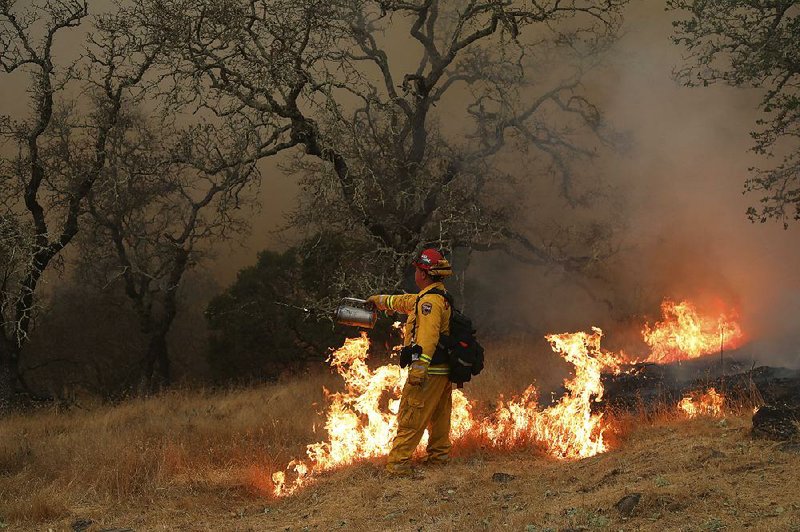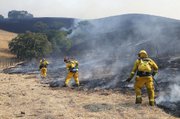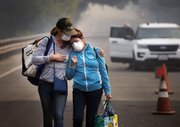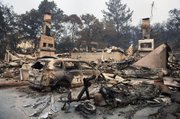SANTA ROSA, Calif. -- The wildfires tearing through California wine country flared anew Wednesday, growing in size and number as authorities issued new evacuation orders and announced that hundreds more homes and businesses had been lost. The death toll climbed to 23 and was expected to rise.
At least 3,500 homes and businesses have been destroyed since the fires started Sunday, making them the third-deadliest and most destructive blazes in state history.
"We have had big fires in the past. This is one of the biggest, most serious, and it's not over," Gov. Jerry Brown said at a news conference alongside the state's top emergency officials, who said that 8,000 firefighters and other personnel were battling the blazes and more resources were pouring in from Oregon, Nevada, Washington and Arizona.
Nearly three days after the flames ignited, firefighters were still unable to gain control of the blazes. California Department of Forestry and Fire Protection spokesman Daniel Berlant said 22 wildfires were burning, up from 17 on Tuesday.
Click here for larger versions
Photos by The Associated Press
Photos by The Associated Press
"Make no mistake, this is a serious, critical, catastrophic event," said Ken Pimlott, chief of the department. He said the fires have burned through 265 square miles of urban and rural areas. The return of high winds and low humidity ignited ground that was parched from years of drought.
"We are literally looking at explosive vegetation," he said. "It is very dynamic. These fires are changing by the minute in many areas."
Officials also feared that strong winds forecast for Wednesday evening and this morning would spread embers to populated areas of Santa Rosa and Calistoga that have so far been spared the flames.
"We are facing some pretty significant monsters," fire agency incident commander Bret Couvea told a room of about 200 firefighters and law enforcement officials at the Sonoma County Fairgrounds staging area Wednesday morning.
[INTERACTIVE MAP: Active wildfires in the U.S.]
Flames have raced across the wine-growing region and the scenic coastal area of Mendocino farther north, leaving little more than smoldering ashes and eye-stinging smoke in their wake. Whole neighborhoods are gone, with only brick chimneys and charred appliances to mark sites that were once family homes.
The two biggest and most destructive fires had consumed more than 70,000 acres in Napa and Sonoma counties by Wednesday morning, up from 52,000 on Tuesday afternoon, according to the state's firefighting agency. In all, six fires had burned more than 91,000 acres in the two counties, and the firefighting agency rated all but the smallest of them as 3 percent contained, or less.
In Mendocino County, where two fires had merged into one, the death toll climbed from two to six in 24 hours.
"What's irking people around here is the national news is only talking about Napa and Sonoma, and we've lost just as much here," Alison de Grassi, spokesman for the Mendocino County Tourism Commission, told the San Jose Mercury News. "People have built their lives around these wineries and these ranches, and now they're gone."
As the fires grew, officials voiced concern about merging infernos.
"These fires are literally just burning faster than firefighters can run in some situations," Emergency Operations Director Mark Ghilarducci said.
Authorities ordered more evacuations for parts of Sonoma Valley after a blaze there grew to 44 square miles.
Sonoma County Sheriff Robert Giordano said that as of late Wednesday morning, 560 people in the county remain unaccounted for, Giordano said. It's unclear if those who are still missing have been harmed, or are simply unable to reach friends and families, as fires have disabled much of the communication system in the region.
Evacuation zones in Sonoma County will remain off limits, partly to limit the possibility of looting, which has resulted in several arrests. Giordano said he doubts residents will be allowed to return to their homes this week.
"If you have a place to go, go; you don't need to be here," Giordano said, later adding, "I can't stress this enough. If you're in an evacuation zone, you cannot come home."
The sheriff also said he expects the death toll to climb. "The devastation is enormous," he said. "We can't even get into most areas."
The entire historic town of Calistoga, population 5,000, was evacuated. Officials went through the town block by block, knocking on doors to warn people to leave, Napa County Supervisor Diane Dillon said.
New evacuation orders were also in place for Green Valley in Solano County.
More than 25,000 people have fled homes from seven counties north of San Francisco, filling dozens of shelters that state officials had hoped to consolidate in the coming days to provide more-efficient services. Many left houses with nothing, and officials acknowledged Tuesday that it could be weeks before some are able to return to what is left. In Sonoma County, 5,000 people had taken refuge in 36 shelters as of Wednesday morning, officials said.
With roads still blocked by police and fires still raging across broad swaths of Northern California, Matt Lenzi hiked through smoke-choked vineyards and waded the Napa River to reach the home his father lived in for 53 years. In its place, he found only blackened debris, blackened earth and ash.
"Every piece of vegetation was gone," Lenzi said Tuesday, after going back in the hope of finding the pet cat that his father, Carl Lenzi, who is in his 80s, left behind when he fled for his life. "Even the barbecue melted, and that's built to take heat."
The scope of the damage prompted President Donald Trump on Tuesday to approve federal emergency assistance to California, agreeing to a request made by Brown. The declaration, announced by Vice President Mike Pence during a visit to the state's Office of Emergency Services near Sacramento, provides immediate funds for debris clearing and supplies for evacuation centers, among other aid.
Brown cautioned that recovery would be very costly but seemed optimistic when asked Wednesday about the fires' impact on California's economy. The wine industry generates more than $55 billion in economic activity in California -- and twice as much nationally -- each year.
"Overall California's economy is very large, about $2.5 trillion... . The machinery of the markets grind on," he said. "I don't think you're going to see a slowdown because of the fires."
Meanwhile in Southern California, cooler weather and moist ocean air helped firefighters gain ground against a wildfire that has scorched more than a dozen square miles.
Orange County Fire Authority Capt. Steve Concialdi said the blaze was nearly halfway surrounded and full containment was expected by Saturday, but another round of gusty winds and low humidity levels could arrive late today.
Information for this article was contributed by Jonathan J. Cooper, Jocelyn Gecker, Olga R. Rodriguez, Juliet Williams and Andrew Dalton of The Associated Press and by Cleve Wootson Jr., Kristine Phillips, Joel Achenbach, Lea Donosky, Breena Kerr, Alissa Greenberg, Scott Wilson, Kimberly Kindy, Herman Wong, J. Freedom du Lac and Amy B. Wang of The Washington Post; by Thomas Fuller, Richard Perez-Pena and Jonah Engel Bromwich of The New York Times; and by Phil Willon, Paige St. John, Louis Sahagun and Sonali Kohli of the Los Angeles Times.
A Section on 10/12/2017



